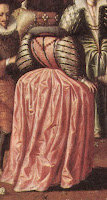Isabella reporting,
Even though fashion thrives on the new, newer, newest, even the most casual survey of fashion history shows that certain trends and styles just keep coming back for another appearance. After writing about
bustles earlier this week, I began thinking of other eras when the emphasis was on the female backside. For the last five centuries or so, this emphasis has come during the '80s - the 1580s, 1680s, 1780s, 1880s, and yes, even the 1980s. It's a coincidence I can't begin to explain, but here's the proof. (As always, please click on the images to enlarge.)
Sixteenth century ladies liked their skirts large and round and shaped like drums. Their skirts were supported by hooped constructions called farthingales. By the 1580s, the most stylish ladies (like these dancing at the French court,
upper left) enhanced their
farthingales further by adding a
bum roll, or French farthingale: a tightly stuffed sausage-shaped pillow that tied around the waist and sat on the hips, adding an extra boost to their farthingales.
A hundred years later, and stylish seventeenth century ladies like the French countess,
right, were choosing mantuas for court c. 1685. Worn over a matching or contrasting petticoat (skirt), a mantua was a trained open gown, draped at the hips, and with a long, trailing train. The mantua was worn over small hoops and stiffened petticoats, and the train was pleated and gathered into an oversized pouf to accentuate the rear view – which this
caricature seems to think is the ideal place for a devil to ride.
Throughout the eighteenth century, hoops grew wider and wider (see
here and
here), but by the 1780s, the width was finally beginning to decrease, with the narrow columnar dresses of the Regency era on the horizon. There was one final exuberant exclamation of fullness,
left, centered on the back skirts. Yards of light-weight fabric were
pleated into the back waist to create the most fullness, and then supported by a pillow-like pad of cork (for lightness) that tied around the waist. This pad was inelegantly referred to as a cork rump, and inspired the caricaturists of the day like
this and
this.
The
mid
-1880s brought bustles at their most extreme,
right. With their steam-punk blending of fashion and invention, these bustles sent a lady's skirts projecting so sharply that they turn up at an acute angle from the waist, as if trying to take flight. No wonder the children are staring in wonder!
By the 1980s, the artificial padding had settled on the shoulders, not the hips and bottom. But the emphasis on the posterior achieved a new intensity with the introduction of designer jeans. Previously jeans were the clothes of rebels, cowboys, and 60s hippies, and few were made to fit a women's figure. Savvy designers soon combined the casual feel of traditional jeans with a skin-tight fit and back pockets that featured studs, rhinestones, appliques, and fancy stitching. Brooke Shields standing with her butt angled outward in her Calvin Klein jeans,
below left, caused a huge furor - even as her posture echoes centuries of past fashions.
Upper left: Evening ball for the wedding of the Duc de Joyeuse, detail, c. 1582,
Louvre.
Upper right: Anne Marie Francoise de Saint Hermine, comtesse d'Mailly, c. 1685
Lower left: Fashion plate, from Magasain des Modes Nouvelles, Francaises et Anglaises, July 1787.
Lower right: Fashion plate: Evening dresses from The Season, vol IV, February 1885. New York Public Library Digital Gallery.
Bottom: Calvin Klein jeans advertisement, featuring Brooke Shields, 1980.





















.jpg)






.jpg)








 One of us --
One of us -- 


